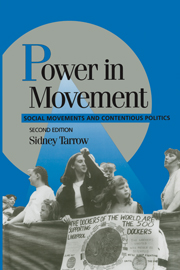Book contents
- Frontmatter
- Contents
- List of Figures
- Preface
- Acknowledgments
- Introduction
- 1 Contentious Politics and Social Movements
- PART 1 THE BIRTH OF THE MODERN SOCIAL MOVEMENT
- 2 Modular Collective Action
- 3 Print and Association
- 4 State Building and Social Movements
- PART II FROM CONTENTION TO SOCIAL MOVEMENTS
- PART III THE DYNAMICS OF MOVEMENT
- Conclusion: The Future of Social Movements
- Notes
- Sources
- Index
- CAMBRIDGE STUDIES IN COMPARATIVE POLITICS
2 - Modular Collective Action
Published online by Cambridge University Press: 05 June 2012
- Frontmatter
- Contents
- List of Figures
- Preface
- Acknowledgments
- Introduction
- 1 Contentious Politics and Social Movements
- PART 1 THE BIRTH OF THE MODERN SOCIAL MOVEMENT
- 2 Modular Collective Action
- 3 Print and Association
- 4 State Building and Social Movements
- PART II FROM CONTENTION TO SOCIAL MOVEMENTS
- PART III THE DYNAMICS OF MOVEMENT
- Conclusion: The Future of Social Movements
- Notes
- Sources
- Index
- CAMBRIDGE STUDIES IN COMPARATIVE POLITICS
Summary
In the mid-1780s, as the foundations of France's old regime were crumbling, a series of scandal trials began to appear in Paris. In one of the most notorious, the Cléraux affair, a servant who had resisted the advances of her master was accused of robbing him and was hauled into court. Not only was the case decided in her favor (pace Dickens), but a wave of popular outrage against the courts and the lewd master surged across Paris. In a routine that had become familiar by the late eighteenth century, the master's house was sacked, his goods thrown into the street, and he himself barely saved from the fury of the crowd. A contemporary observer described the émotion in this way:
What violences! What tumults! A furious multitude filled the streets, straining to tear down the Thibault house with an ax, then threatening to burn it; covering the family with curses and outrages; almost sacrificing them to their hatred.
(Lusebrink 1983: 375–6)The affair contributed to the atmosphere of corruption surrounding the Old Regime, but its forms and its rhetoric were familiar from the European past.
Sixty years later, in February 1848, Alexis de Tocqueville left his house for parliament amid the tumult of Paris in revolution. Along his route, as citizens quietly watched, men were systematically putting up barricades. “These barricades,” he observed,
were skillfully constructed by a small number of men who worked industriously – not like criminals fearful of being caught in flagrante delicto, but like good workmen who wanted to do their job expeditiously and well. […]
- Type
- Chapter
- Information
- Power in MovementSocial Movements and Contentious Politics, pp. 29 - 42Publisher: Cambridge University PressPrint publication year: 1998
- 1
- Cited by

